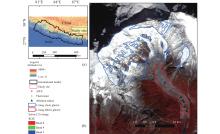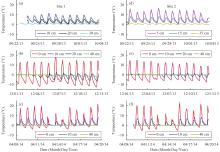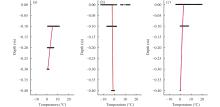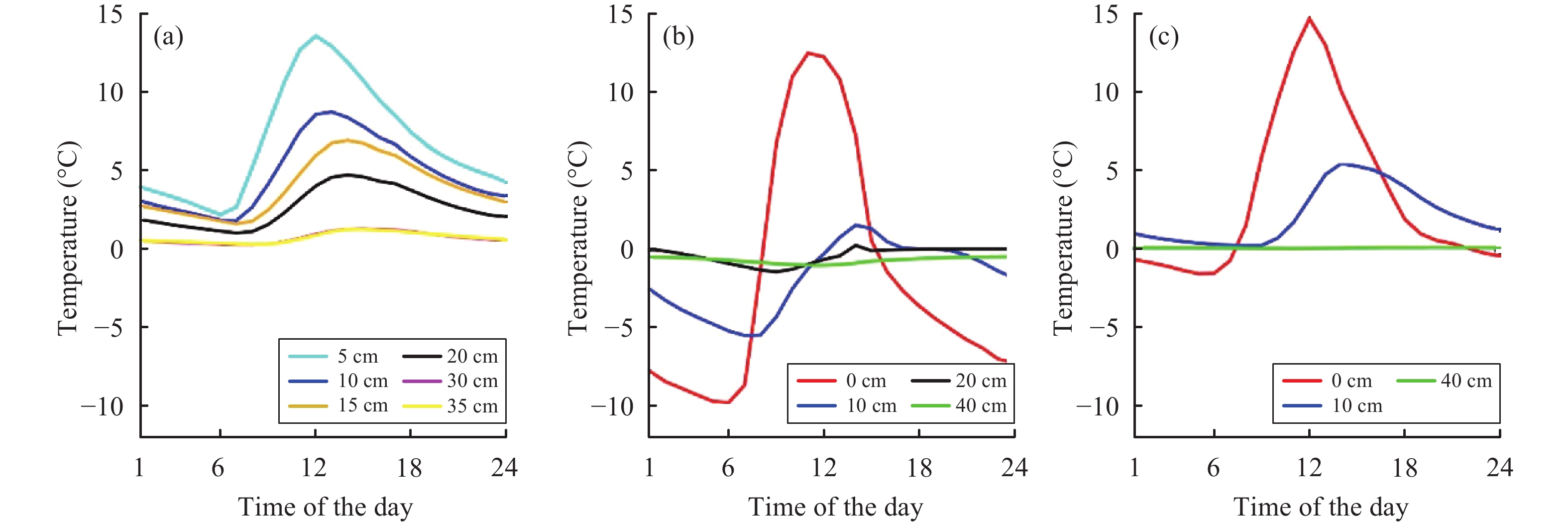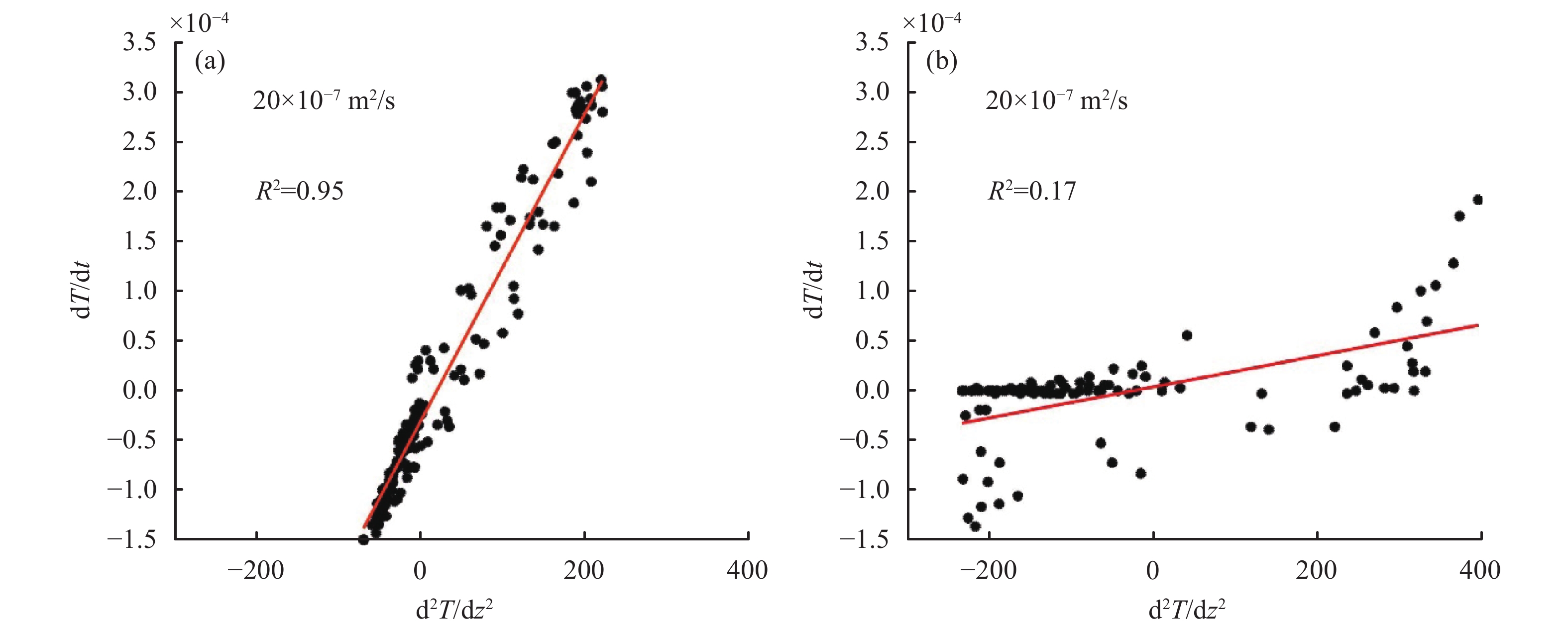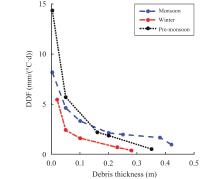Sciences in Cold and Arid Regions ›› 2018, Vol. 10 ›› Issue (5): 357–368.doi: 10.3724/SP.J.1226.2018.00357
• • 下一篇
Study of thermal properties of supraglacial debris and degree-day factors on Lirung Glacier, Nepal
Mohan Bahadur Chand1,2,*( ),Rijan Bhakta Kayastha2
),Rijan Bhakta Kayastha2
- 1 Graduate School of Environmental Science, Hokkaido University, Sapporo 060-0810, Japan
2 Himalayan Cryosphere, Climate and Disaster Research Center (HiCCDRC), Kathmandu University, Dhulikhel 45200, Nepal
| 1 | Bajracharya SR, Maharjan SB, Shrestha F, et al., 2014. Glacier status in Nepal and decadal change from 1980 to 2010 based on Landsat data. Kathmandu: ICIMOD. |
| 2 |
Benn DI, Bolch T, Hands K, et al. Response of debris-covered glaciers in the Mount Everest region to recent warming, and implications for outburst flood hazards. Earth-Science Reviews 2012; 114: 1–2 156- 174.
doi: 10.1016/j.earscirev.2012.03.008 |
| 3 |
Bolch T, Buchroithner M, Pieczonka T, et al. Planimetric and volumetric glacier changes in the Khumbu Himal, Nepal, since 1962 using Corona, Landsat TM and ASTER data. Journal of Glaciology 2008; 54: 187 592- 600.
doi: 10.3189/002214308786570782 |
| 4 |
Bolch T, Pieczonka T, Benn DI Multi-decadal mass loss of glaciers in the Everest area (Nepal Himalaya) derived from stereo imagery. The Cryosphere 2011; 5: 2 349- 358.
doi: 10.5194/tc-5-349-2011 |
| 5 |
Bolch T, Kulkarni A, Kääb A, et al. The state and fate of Himalayan glaciers. Science 2012; 336: 6079 310- 314.
doi: 10.1126/science.1215828 |
| 6 |
Braithwaite RJ Positive degree-day factors for ablation on the Greenland ice sheet studied by energy-balance modelling. Journal of Glaciology 1995; 41: 137 153- 160.
doi: 10.1017/S0022143000017846 |
| 7 |
Byers AC, McKinney DC, Somos-Valenzuela M, et al. Glacial lakes of the Hinku and Hongu valleys, Makalu Barun National Park and Buffer Zone, Nepal. Natural Hazards 2013; 69: 1 115- 139.
doi: 10.1007/s11069-013-0689-8 |
| 8 |
Chand MB, Kayastha RB, Parajuli A, et al. Seasonal variation of ice melting on varying layers of debris of Lirung Glacier, Langtang Valley, Nepal. Proceedings of the International Association of Hydrological Sciences 2015; 368: 21- 26.
doi: 10.5194/piahs-368-21-2015 |
| 9 | Conway H, Rasmussen LA, 2000. Summer Temperature profiles within supraglacial debris on Khumbu Glacier, Nepal. In: Nakawo M, Raymond CF, Fountain A (eds.). Debris-Covered Glaciers. Washington, USA: IAHS, pp. 89–97. |
| 10 |
Foster LA, Brock BW, Cutler MEJ, et al. A physically based method for estimating supraglacial debris thickness from thermal band remote-sensing data. Journal of Glaciology 2012; 58: 210 677- 691.
doi: 10.3189/2012JoG11J194 |
| 11 |
Fujii Y, Higuchi K Statistical analyses of the forms of the glaciers in the Khumbu himal. Journal of the Japanese Society of Snow and Ice 1977; 39: 7- 14.
doi: 10.5331/seppyo.39.Special_7 |
| 12 |
Fujii Y Field experiment on glacier ablation under a layer of debris cover. Journal of the Japanese Society of Snow and Ice 1977; 39: 20- 21.
doi: 10.5331/seppyo.39.Special_20 |
| 13 | Fujita K, Sakai A, 2000. Air temperature environment on the debris-covered area of Lirung Glacier, Langtang Valley, Nepal Himalayas. In: Nakawo M, Raymond CF, Fountain A (eds.). Debris-Covered Glaciers. Washington, USA: IAHS, pp. 83–84. |
| 14 |
Gardelle J, Arnaud Y, Berthier E Contrasted evolution of glacial lakes along the Hindu Kush Himalaya mountain range between 1990 and 2009. Global and Planetary Change 2011; 75: 1–2 47- 55.
doi: 10.1016/j.gloplacha.2010.10.003 |
| 15 | Hagg W, Brook M, Mayer C, et al. A short-term field experiment on sub-debris melt at the highly maritime Franz Josef Glacier, Southern Alps, New Zealand. Journal of Hydrology 2014; 53: 2 153- 161. |
| 16 |
Han HD, Ding YJ, Liu SY A simple model to estimate ice ablation under a thick debris layer. Journal of Glaciology 2006; 52: 179 528- 536.
doi: 10.3189/172756506781828395 |
| 17 |
Huang L, Li Z, Tian BS, et al. Estimation of supraglacial debris thickness using a novel target decomposition on L-band polarimetric SAR images in the Tianshan Mountains. Journal of Geophysical Research 2017; 122: 4 925- 940.
doi: 10.1002/2016JF004102 |
| 18 |
Juen M, Mayer C, Lambrecht A, et al. Thermal properties of a supraglacial debris layer with respect to lithology and grain size. Geografiska Annaler: Series A, Physical Geography 2013; 95: 3 197- 209.
doi: 10.1111/geoa.12011 |
| 19 |
Kääb A, Berthier E, Nuth C, et al. Contrasting patterns of early twenty-first-century glacier mass change in the Himalayas. Nature 2012; 488: 7412 495- 598.
doi: 10.1038/nature11324 |
| 20 | Kayastha RB, Takeuchi Y, Nakawo M, et al., 2000. Practical prediction of ice melting beneath various thickness of debris cover on Khumbu Glacier, Nepal, using a positive degree-day factor. In: Nakawo M, Raymond CF, Fountain A (eds.). Debris-Covered Glaciers. Washington, USA: IAHS, pp. 71–81. |
| 21 | Kayastha RB, Ageta Y, Nakawo M, et al. Positive degree-day factors for ice ablation on four glaciers in the Nepalese Himalayas and Qinghai-Tibetan Plateau. Bulletin of Glaciological Research 2003; 20: 7- 14. |
| 22 |
Kraaijenbrink PDA, Bierkens MFP, Lutz AF, et al. Impact of a global temperature rise of 1.5 degrees Celsius on Asia's glaciers. Nature 2017; 549: 7671 257- 260.
doi: 10.1038/nature23878 |
| 23 | Mattson LE, Gardner JS, Young GJ, 1993. Ablation on debris covered glaciers: an example from the Rakhiot Glacier, Punjab, Himalaya. In: Young GJ (ed.). Snow and Glacier Hydrology. Kathmandu, Nepal: IAHS, pp. 289–296. |
| 24 |
McCarthy M, Pritchard H, Willis I, et al. Ground-penetrating radar measurements of debris thickness on Lirung Glacier, Nepal. Journal of Glaciology 2017; 63: 239 543- 555.
doi: 10.1017/jog.2017.18 |
| 25 |
Mihalcea C, Mayer C, Diolaiuti G, et al. Spatial distribution of debris thickness and melting from remote-sensing and meteorological data, at debris-covered Baltoro glacier, Karakoram, Pakistan. Annals of Glaciology 2008; 48: 49- 57.
doi: 10.3189/172756408784700680 |
| 26 |
Nakawo M, Young GJ Estimate of glacier ablation under a debris layer from surface temperature and meteorological variables. Journal of Glaciology 1982; 28: 98 29- 34.
doi: 10.3189/s002214300001176X |
| 27 |
Nakawo M, Rana B Estimate of ablation rate of glacier ice under a supraglacial debris layer. Geografiska Annaler: Series A, Physical Geography 1999; 81: 4 695- 701.
doi: 10.1111/geoa.1999.81.issue-4 |
| 28 |
Nicholson L, Benn DI Calculating ice melt beneath a debris layer using meteorological data. Journal of Glaciology 2006; 52: 178 463- 470.
doi: 10.3189/172756506781828584 |
| 29 |
Nicholson L, Benn DI Properties of natural supraglacial debris in relation to modelling sub-debris ice ablation. Earth Surface Processes and Landforms 2013; 38: 5 490- 501.
doi: 10.1002/esp.3299 |
| 30 |
Östrem G Ice melting under a thin layer of moraine, and the existence of ice cores in moraine ridges. Geografiska Annaler 1959; 41: 4 228- 230.
doi: 10.1080/20014422.1959.11907953 |
| 31 |
Qiao L, Mayer C, Liu SY Distribution and interannual variability of supraglacial lakes on debris-covered glaciers in the Khan Tengri-Tumor Mountains, Central Asia. Environmental Research Letters 2015; 10: 1 014014.
doi: 10.1088/1748-9326/10/1/014014 |
| 32 |
Reid TD, Brock BW An energy-balance model for debris-covered glaciers including heat conduction through the debris layer. Journal of Glaciology 2010; 56: 199 903- 916.
doi: 10.3189/002214310794457218 |
| 33 |
Reid TD, Brock BW Assessing ice-cliff backwasting and its contribution to total ablation of debris-covered Miage glacier, Mont Blanc massif, Italy. Journal of Glaciology 2014; 60: 219 3- 13.
doi: 10.3189/2014JoG13J045 |
| 34 |
Reznichenko N, Davies T, Shulmeister J, et al. Effects of debris on ice-surface melting rates: an experimental study. Journal of Glaciology 2010; 56: 197 384- 394.
doi: 10.3189/002214310792447725 |
| 35 |
Rounce DR, McKinney DC Debris thickness of glaciers in the Everest area (Nepal Himalaya) derived from satellite imagery using a nonlinear energy balance model. The Cryosphere 2014; 8: 4 1317- 1329.
doi: 10.5194/tc-8-1317-2014 |
| 36 |
Rounce DR, Quincey DJ, McKinney DC Debris-covered glacier energy balance model for Imja-Lhotse Shar glacier in the Everest region of Nepal. The Cryosphere 2015; 9: 6 2295- 2310.
doi: 10.5194/tc-9-2295-2015 |
| 37 |
Schauwecker S, Rohrer M, Huggel C, et al. Remotely sensed debris thickness mapping of Bara Shigri Glacier, Indian Himalaya. Journal of Glaciology 2015; 61: 228 675- 688.
doi: 10.3189/2015JoG14J102 |
| 38 |
Scherler D, Bookhagen B, Strecker MR Spatially variable response of Himalayan glaciers to climate change affected by debris cover. Nature Geoscience 2011; 4: 3 156- 159.
doi: 10.1038/ngeo1068 |
| 39 |
Shahi S, Kayastha RB Influence of a debris layer on the melting of ice on Lirung Glacier, Langtang Valley, Rasuwa, Nepal. Journal of Hydrology and Meteorology 2015; 9: 1 95- 108.
doi: 10.3126/jhm.v9i1.15585 |
| 40 |
Singh P, Kumar N, Arora M Degree-day factors for snow and ice for Dokriani Glacier, Garhwal Himalayas. Journal of Hydrology 2000; 235: 1–2 1- 11.
doi: 10.1016/S0022-1694(00)00249-3 |
| 41 |
Steiner JF, Pellicciotti F Variability of air temperature over a debris-covered glacier in the Nepalese Himalaya. Annals of Glaciology 2016; 57: 71 295- 307.
doi: 10.3189/2016AoG71A066 |
| 42 | Takeuchi Y, Kayastha RB, Nakawo M, 2000. Characteristics of ablation and heat balance in debris-free and debris-covered areas on Kumubu Glacier, Nepal Himalaya, in the pre-monsoon season. In: Nakawo M, Raymond CF, Fountain A (eds.). Debris-Covered Glaciers. Washington, USA: IAHS, pp. 53–61. |
| 43 | Xu M, Han HD, Kang SC The temporal and spatial variation of positive degree-day factors on the Koxkar Glacier over the south slope of the Tianshan Mountains, China, from 2005 to 2010. Sciences in Cold and Arid Regions 2017; 9: 5 425- 431. |
| No related articles found! |

